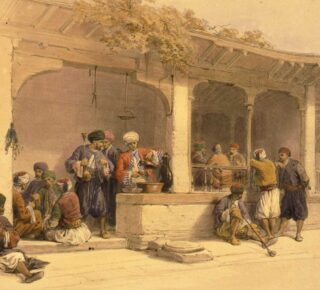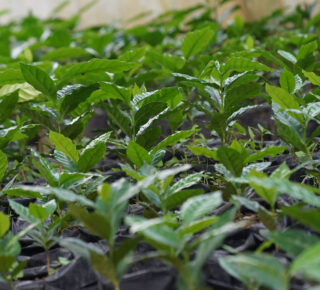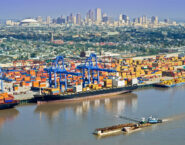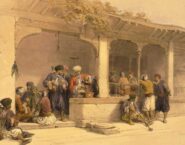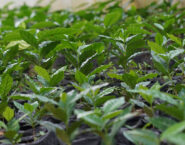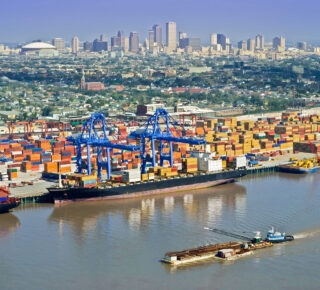
Where is coffee grown? In more than 40 countries, mostly in a narrow climactic zone along the Equator between the Tropics of Cancer and Capricorn (25°N to 30°S)!
The world’s coffee-growing regions are the source of much of the world’s coffee. They offer the ideal conditions for coffee trees to flourish: rich soil, mild temperatures, regular seasonal rainfall, and shaded sun. Coffee trees are picky—outside of these coffee regions, with their specific latitudes and mild climactic zones, they’re unlikely to thrive.
While all coffees have characteristics shaped by where they’re grown, many coffees on the market are blends, combining coffees of different origins. Single-origin coffees, however, come from one farm, region or country and emphasize a distinctive and often complex flavor. This “flavor profile” is associated with a strong sense of place. If you want to experience the unique sensory profile of a particular place, look for a single-origin coffee from that location!
Coffee Regions and Countries
Brazil | Colombia | Costa Rica | Ethiopia | Guatemala | Indonesia | Ivory Coast | Kenya | Mexico | Puerto Rico | Hawaii | Vietnam | Yemen
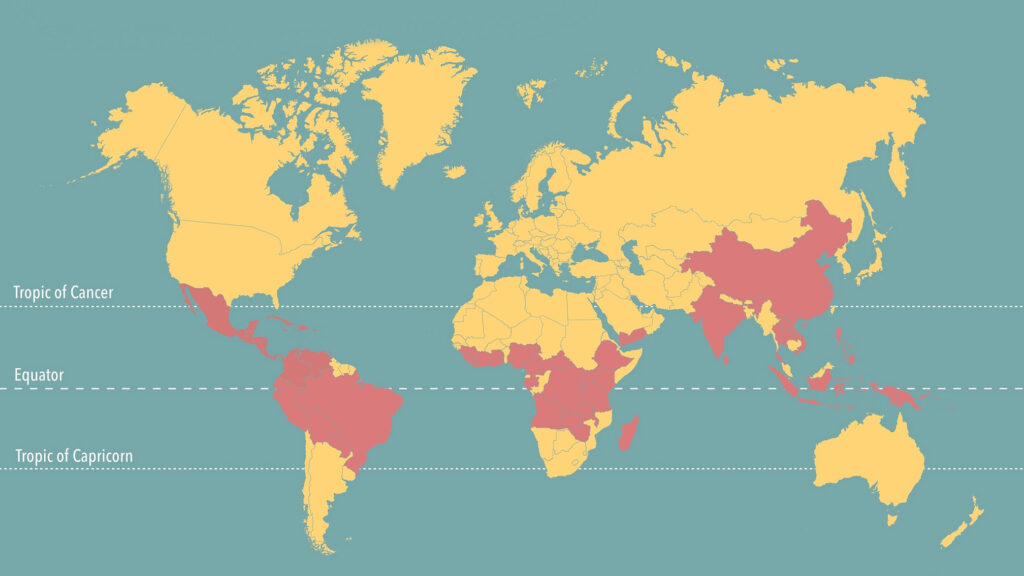
Where is coffee grown?
While coffee trees thrive in all the coffee regions of the world, each region produces coffee with a unique flavor, fragrance, and appearance. These variations are the result of a complex combination of factors, including the coffee plant variety, the local terroir (chemistry of the soil, microclimates, and sunlight), and even the precise altitude of the farm or plantation. Even elements as specific as fog can influence the final flavor profile and characteristics of each bean.
Here’s a snapshot of just some of the coffee-growing regions and countries in the world—and some of what distinguishes their well-loved brews.
North America and the Caribbean
Mexico
- Growing locations: Mostly in the southern states of Veracruz, Oaxaca, and Chiapas.
- Growing conditions: Grown at altitude with cooler temperatures and shade, which allows for slower bean development and more complex flavors to develop.
- Known for: Most coffees are washed arabicas, which have coffee with wonderful aromas and depth of flavor, often with a pronounced sharpness. A Mexican coffee designated Altura means that it was grown at high altitudes, maturing more slowly and developing more complex flavor.
- Distinctive details: Small Mexican coffee farms are more common than large plantations, but with over 100,000 coffee farmers, Mexico ranks as one of the largest coffee-producing countries in the world.
Puerto Rico
- Growing locations: Throughout the island of Puerto Rico, in mountainous areas such as Grand Lares and La Cordillera in the south-central region and Yauco Selecto in the southwest.
- Growing conditions: Grown at elevations of 1,800–3,500 feet, with shade cover.
- Known for: Arabica coffee with balanced body and pleasant acidity, as well as a fruity aroma.
- Distinctive details: Coffee was brought to Puerto Rico from Martinique in 1736, and by the late 19th century, it was the sixth leading exporter of coffee in the world. In the wake of major hurricanes and fierce industry competition, Puerto Rico’s coffee industry took a backseat for a while—but is now being revived with carefully cultivated coffee from quality arabica varieties produced to the highest standards.
Hawaii
- Growing locations: Throughout the Hawaiian Islands.
- Growing conditions: Afternoon shade from tropical clouds forms a natural canopy over the coffee plants to protect them from intense sun, and frequent island showers give the plants just the right amount of rain.
- Known for: Several of the Hawaiian Islands produce their own distinctive coffees. Kona and Ka’u coffee come from the Big Island of Hawaii, and Kauai coffee from the island of its namesake. Kona coffee comes from a very narrow region of the Big Island and produces coffees that are deliciously rich and aromatic with medium body. Coffee from Kauai is smooth and has light floral notes.
- Distinctive details: Hawaiian coffees are known for being grown in rich volcanic soils that benefit flavor development of the beans.
Central America
Costa Rica
- Growing locations: Predominantly small farms, or fincas. Predominant growing areas are in Tarrazú, Tres Rios, and Naranjo.
- Growing conditions: A dry season from November to April and a rainy season from May to October.
- Known for: Arabica coffee with medium body and sharp acidity, often described as having perfect balance.
- Distinctive details: Costa Rican coffees are often washed arabicas, produced at the country’s beneficios, or state-of-the-art processing facilities. The careful attention to quality processing and conscientious growing methods have built Costa Rica’s reputation for fine coffee.
Guatemala
- Growing locations: Antigua, Coban, and Huehuetanango.
- Growing conditions: Breathtakingly rugged landscapes and rich volcanic soil.
- Known for: Medium-to-full-bodied coffee with depth and complex, rich flavor that is almost spicy or chocolatey. Also produces coffees characteristic to a Central American flavor profile that are known for a “citric” note, with higher acidity and notes of citrus fruit.
- Distinctive details: “Strictly hard beans,” the highest grade of coffee produced in Guatemala, are grown at an altitude of 4,500 feet or higher, providing more complex flavors.
Honduras
- Growing locations: Santa Barbara, La Paz, Santa Rosa, Copan, Lempira.
- Growing conditions: Low elevation to high-grown arabicas.
- Known for: Quality arabica coffees ranging from moderate quality that’s lower in acidity to high-grown and high-quality arabicas known for bright acidity and citric notes.
- Distinctive details: The high-grown arabicas have fruit that matures more slowly, allowing the cherries and seeds (beans) to develop more complex flavors. It also yields a harder, denser bean.
South America
Brazil
- Growing locations: Growing areas include SãoPaolo, Minas Gerais, and Paraná.
- Growing conditions: Brazil’s coffee-producing regions have historically hosted near ideal growing conditions of 59–77 degrees Fahrenheit for arabica and 68–86 degrees Fahrenheit for robusta. More recently, climatic conditions have at times varied, creating less favorable conditions for production.
- Known for: Clear, sweet, medium-bodied, and low-acid coffee.
- Distinctive details: Brazil is the top coffee-producing country in the world by volume, growing both arabica and robusta. With hundreds of thousands of coffee plantations across many states, a third of all the world’s coffee comes from Brazil. Coffee plantations in Brazil often cover immense areas of land, employing hundreds of people to produce huge quantities of coffee, and may be machine harvested, which is possible when coffee is grown on large flat areas.
Colombia
- Growing locations: Quindío, Caldas, Cundinamarca, Tolima, Nariño, Huila, Santander, Sierra Nevada de Santa Marta, and Antioquia.
- Growing conditions: A rugged and mountainous landscape with the perfect natural environment for coffee.
- Known for: Consistently good, mild coffees, with a well-balanced acidity. Colombian Supremo, the highest grade, has a delicate, aromatic sweetness while Excelso Grade is softer and slightly more acidic. The Juan Valdez™ advertising campaigns popularized Colombian coffee to much of the world.
- Distinctive details: Colombia is probably the world’s best-known coffee producer and ranks third worldwide in yearly production. Colombia is one of the few places in the world where coffee trees grow year-round—there are two harvests per year. The rough terrain makes it difficult to transport the harvested coffee beans to production and shipment centers, so even today, this is often done by mule, horse, or Jeep.
Peru
- Growing locations: Some notable areas include Amazonas, Cajamarca, Pasco, and Cusco.
- Growing conditions: A large variation in elevation and climate zones contribute to a rich diversity in coffee varieties and sensory profiles. More recently, unusual weather events like unpredictable rains have impacted the harvest.
- Known for: Balanced arabicas with mild acidity and nutty flavor notes to juicy and deep fruity flavors.
- Distinctive details: Coffee from Peru offers a range of sensory profiles due to the large variation in mountainous growing regions abutting the Andes. Peru also has historically been one of the world’s top producers of organic coffee.
East Africa
Ethiopia
- Growing locations: Sidamo, Harrar, Yergacheffe, and Kaffa.
- Growing conditions: Ethiopia affords some of the highest altitude production areas for arabica coffee, allowing the fruits to mature very slowly and develop complex flavors like fruity, spicy, and floral. The coffee is also grown under partial shade.
- Known for: Bold, full-flavored, full-bodied coffee that’s a bit down-to-earth. Coffees can also have high, supple acidity. Most arabica coffees are produced using the natural processing method.
- Distinctive details: According to the legend of Kaldi the goatherder, the benefits of coffee beans and brewed coffee were first discovered on the Ethiopian Plateau, where ancient coffee forests still thrive today. Ethiopia also has “heirloom” coffee varieties, which are loosely defined as wild or genetically undefined varieties native to the country. These rare varieties offer unusual flavor profiles, and while some only grow in the wild, others have been brought to specialty coffee farms for production.
Kenya
- Growing locations: The foothills of Mount Kenya, often on small farms.
- Growing conditions: The high elevation and terroir of the land are ideal for coffee production.
- Known for: Full-bodied coffee with a sharp, fruity acidity, and a rich fragrance.
- Distinctive details: Kenyan producers emphasize quality and carefully control and monitor processing and drying procedures. Kenya has a unique grading system, classifying beans by their size, shape and density. The highest grade is Kenyan AA, and AA+ means that it was estate grown.
West Africa
Ivory Coast
- Growing regions: Abboisso, Abengourou, and Divo.
- Growing conditions: A tropical climate with relatively low elevations of 1,000–1,300 feet growing primarily robusta coffee.
- Known for: Strongly aromatic and astringent robusta coffee that is processed using the natural processing method.
- Distinctive details: The Ivory Coast produces a significant amount of robusta coffee, but it is also known for growing arabusta, a hybrid of arabica and robusta. Arabusta trees grow at a much slower rate than robusta, but they produce coffee with a sweeter, milder taste.
The Arabian Peninsula
Yemen
- Growing locations: Family farms with small, terraced gardens.
- Growing conditions: Arid land.
- Known for: Coffee with a distinctly deep, rich taste.
- Distinctive details: Coffee was first cultivated commercially in Yemen, and coffee is still grown in its age-old, century-proven manner. Since water is scarce, coffee beans tend to be smaller and more irregular in size and shape, and producers use dry processing methods. These methods produce coffees that often taste fruity and have a nice body.
Asia
India
- Growing locations: Historically, the southern regions of Kerala, Tamil Nadu, and Karnataka; more recently, Andhra Pradesh and Orissa.
- Growing conditions: Two-tier mixed shade canopy. Arabica coffees are grown at 3,200–4,900 feet and cooler temperatures of 59–77 degrees Fahrenheit, and robusta coffees are grown at 1,600–3,300 feet and warmer temperatures of 68–86 degrees Fahrenheit and high humidity.
- Known for: Mild arabicas and robustas. Some top varieties include S.795, Kents, Cauvery (Catimor), and Selection 9 (Sin. 9).
- Distinctive details: Coffee cultivated in India can be produced during the annual monsoon season, exposing coffee beans to humid monsoon air. The beans can pick up moisture and change color to pale gold and have lower acidity, becoming “milds.” This is known as monsooned coffee.
Indonesia
- Growing locations: The islands of Sumatra, Java, and Sulawesi, on predominantly small, 1- or 2-acre farms.
- Growing conditions: Warm, damp climate.
- Known for: Fine quality coffee with a rich, full body and mild acidity.
- Distinctive details: Indonesia has been known for its fine, aged coffees since Dutch colonists introduced the coffee tree in the 17th century. Indonesian farmers still use an age-old process, warehousing the coffee for a designated time to achieve an even deeper body and less acidity. This timeless process cannot be matched even by the latest technology, and the coffees it produces may have notes of earthiness, tobacco, spice, and leather.
Vietnam
- Growing locations: The southern half of the country, on small plantations.
- Growing conditions: On a Central Highlands plateau at about 2,000 feet in elevation.
- Known for: Robusta coffee with low acidity and fuller body, astringent, frequently used for blending.
- Distinctive details: Coffee’s presence in Vietnam dates back to the mid-19th century, when it was introduced by French missionaries. Today, the coffee industry is growing so rapidly that the country has become the world’s second largest producer. Vietnam produces more robusta than any other place on Earth. Rice is the only crop more important than coffee in Vietnam. In fact, the country has its own unique coffee brewing filter, known as the phin.
Not ready to finish your coffee journey around the world? Learn more about the global history of coffee (spoiler: goats are involved) and lifecycle of coffee from seed to recycled coffee grounds.

